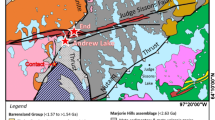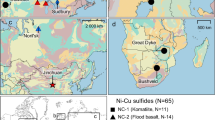Abstract
Uni- and multivariate statistical analyses of trace element laser-ablation inductively coupled plasma mass spectrometry data for Fe-oxides from banded iron formation (BIF) and BIF-hosted ores in 13 deposits/prospects of the Middleback Ranges, South Australia are presented. The obtained trace element signatures were considered within a petrographic-textural framework of iron-oxide evolution from magnetite through clean martite and porous martite to platy hematite, to evaluate changes in trace element concentrations with respect to the ore enrichment processes. Statistically valid distinctions among different hematite textures were indicated for most trace elements by linear mixed-effects models. Furthermore, the hematite data showed significant intra-class correlations between spot-analyses within individual polished blocks and correlations between polished blocks within individual deposits. The data are thus aggregated within their hierarchical levels. Two linear discriminant function analyses were performed to determine the combinations of trace elements that can distinguish hematite by textures and by location within the Middleback Ranges. Tin, a significant discriminator element in both models, reflects the regional influence of granite-affiliated hydrothermal fluids on the clean martite. This granitic signature, therefore, postdates formation of magnetite BIFs and potentially represents a supergene ore enrichment stage. The combination of Ni, Co, Ti and Nb was discovered to be uniquely attributed to discrimination of the Northern and Southern Middleback Ranges, indicating very specific local settings unrelated to hematite textures. Both local and regional settings impacting on the trace element signatures of Fe-oxides throughout iron ore formation are recognised, suggesting distinct ore enrichment conditions within various segments of the belt.









Similar content being viewed by others
References
Aitchison J (1986) The statistical analysis of compositional data. Monographs on statistics and applied probability. Chapman and Hall Ltd. (Reprinted 2003 with additional material by The Blackburn Press), London. http://dx.doi.org/10.1007/978-94-009-4109-0
Aitchison J, Barceló-Vidal C, Pawlowsky-Glahn V (2002) Some comments on compositional data analysis in archaeometry, in particular the fallacies in Tangri and Wright’s dismissal of logratio analysis. Archaeom 44:295–304. https://doi.org/10.1111/1475-4754.t01-1-00061
Angerer T, Hagemann SG, Danyushevsky LV (2013) High-grade iron ore at Windarling, Yilgarn Craton: a product of syn-orogenic deformation, hypogene hydrothermal alteration and supergene modification in an Archean BIF-basalt lithostratigraphy. Miner Depos 48:697–728. https://doi.org/10.1007/s00126-012-0450-3
Bates D, Maechler M, Bolker B, Walker S (2015) Fitting linear mixed-effects models using lme4. J Stat Softw 67:1–48. https://doi.org/10.18637/jss.v067.i01
Belissont R, Boiron MC, Luais B, Cathelinea M (2014) LA-ICP-MS analyses of minor and trace elements and bulk Ge isotopes in zoned Ge-rich sphalerites from the Noailhac-Saint-Salvy deposit (France): insights into incorporation mechanisms and ore deposition processes. Geochim Cosmochim Acta 126:518–540. https://doi.org/10.1016/j.gca.2013.10.052
Bhattacharya HN, Chakraborty I, Ghosh K (2007) Geochemistry of some banded iron formations of the Archean supracrustals, Jharkhand-Orissa region, India. J Earth Syst Sci 116:245–259. https://doi.org/10.1007/s12040-007-0024-4
Corbeil RR, Searle SR (1976) Restricted maximum likelihood (REML) estimation of variance components in the mixed model. Technometrics 18:31–38. https://doi.org/10.2307/1267913
Creaser RA, Fanning CM (1993) A U-Pb zircon study of the Mesoproterozoic Charleston Granite, Gawler Craton, South Australia. Aust J Earth Sci 40:519–526. https://doi.org/10.1080/08120099308728101
Dalstra HJ, Rosière CA (2008) Structural controls on high-grade iron ores hosted by banded iron formation: a global perspective. Rev Econ Geol 15:73–106. https://doi.org/10.5382/Rev.15.03
Davies MB (2000) Iron ore in South Australia. Primary industries and resources SA. Commod Rev 8:35
Dempster AP, Laird NM, Rubin DB (1977) Maximum likelihood from incomplete data via the EM algorithm. J R Stat Soc 39:1–38. https://doi.org/10.2307/2984875
Dupuis C, Beaudoin G (2011) Discriminant diagrams for iron oxide trace element fingerprinting of mineral deposit types. Miner Depos 46:319–335. https://doi.org/10.1007/s00126-011-0334-y
Frenzel M, Hirsch T, Gutzmer J (2016) Gallium, germanium, indium, and other trace and minor elements in sphalerite as a function of deposit type—A meta-analysis. Ore Geol Rev 76:52–78. https://doi.org/10.1016/j.oregeorev.2015.12.017
Gabriel KR (1971) The biplot graphical display of matrices with application to principal component analysis. Biometrika 58:453–467. https://doi.org/10.1093/biomet/58.3.453
Günther T, Klemd R, Zhang X, Horn I, Weyer S (2017) In-situ trace element and Fe-isotope studies on magnetite of the volcanic-hosted Zhibo and Chagangnuoer iron ore deposits in the Western Tianshan, NW China. Chem Geol 453:111–127. https://doi.org/10.1016/j.chemgeo.2017.02.001
Hagemann SG, Angerer T, Duuring P, Rosière CA, Figueiredo e Silva RC, Lobato LM, Hensler A-S, Walde DHG (2016) BIF-hosted iron mineral system: a review. Ore Geol Rev 76:317–359. https://doi.org/10.1016/j.oregeorev.2015.11.004
Hensler A, Hagemann SG, Rosière CA, Angerer T, Gilbert S (2015) Hydrothermal and metamorphic fluid-rock interaction associated with hypogene “hard” iron ore mineralisation in the Quadrilátero Ferrífero, Brazil: implications from in-situ laser ablation ICP-MS iron oxide chemistry. Ore Geol Rev 69:325–351. https://doi.org/10.1016/j.oregeorev.2015.02.023
Honaker J, King G, Blackwell M (2011) Amelia II: a program for missing data. J Stat Softw 45:1–47. https://doi.org/10.18637/jss.v045.i07
Johnson R, Wichern D (2007) Applied multivariate statistical analysis, 6th edn. Springer, New York
Keyser K, Ciobanu CL, Cook NJ, Johnson G, Feltus H, Johnson S, Dmitrijeva M, Ehrig K, Nguyen PT (2018) Petrography and trace element signatures of iron-oxides in deposits from the Middleback Ranges, South Australia: from banded iron formation to ore. Ore Geol Rev 93:337–360. https://doi.org/10.1016/j.oregeorev.2018.01.006
Makvandi S, Ghasemzadeh-Barvarz M, Beaudoin G, Grunsky EC, McClenaghan MB, Duchesne C, McClenaghan MB, Duchesne C (2016a) Principal component analysis of magnetite composition from volcanogenic massive sulfide deposits: case studies from the Izok Lake (Nunavut, Canada) and Halfmile Lake (New Brunswick, Canada) deposits. Ore Geol Rev 72:60–85. https://doi.org/10.1016/j.oregeorev.2015.06.023
Makvandi S, Ghasemzadeh-Barvarz M, Beaudoin G, Grunsky EC, McClenaghan MB, Duchesne C, Boutroy E (2016b) Partial least squares-discriminant analysis of trace element compositions of magnetite from various VMS deposit subtypes: application to mineral exploration. Ore Geol Rev 78:388–408. https://doi.org/10.1016/j.oregeorev.2016.04.014
McAvaney S (2012) The Cooyerdoo Granite: Paleo- and Mesoarchean basement of the Gawler Craton. MESA J 65:31–40
McIntyre JI (2001) Middleback Ranges Project—South Australia. EL 2763 Annual Report. Helix Resources N.L
Morris RC (2012) Microplaty hematite—Its varied nature and genesis. Aust J Earth Sci 59:411–434
Parker AJ (1993) The geology of South Australia, volume 1—The Precambrian. Geological Survey of South Australia, Bulletin, p 54
Pawlowsky-Glahn V, Egozcue JJ (2006) Compositional data and their analysis: an introduction. Geol Soc Lond Spec Publ 264:1–10. https://doi.org/10.1144/GSL.SP.2006.264.01.01
Peacock M (2016) Structural geology & high-grade iron ore mineralisation, Middleback Ranges, South Australia, Honours Thesis, The Australian National University
Pirajno F, Hoatson DM (2012) A review of Australia’s Large Igneous Provinces and associated mineral systems: implications for mantle dynamics through geological time. Ore Geol Rev 48:2–54
R Core Team (2017) R: a language and environment for statistical computing. R Foundation for Statistical Computing, Vienna, Austria. https://www.R-project.org. Accessed 20 July 2017
Reid A, Hand M (2012) Mesoarchean to Mesoproterozoic evolution of the southern Gawler Craton, South Australia. Episodes 35:216–225
Szpunar M, Hand M, Barovich K, Jagodzinski E, Belousova E (2011) Isotopic and geochemical constraints on the Paleoproterozoic Hutchison Group, southern Australia: implications for Paleoproterozoic continental reconstructions. Precambrian Res 187:99–126. https://doi.org/10.1016/j.precamres.2011.02.006
Taylor D, Dalstra HJ, Harding AE, Broadbent GC, Barley ME (2001) Genesis of high-grade hematite orebodies of the Hamersley Province, Western Australia. Econ Geol 96:837–873. https://doi.org/10.2113/gsecongeo.96.4.837
Van Achterbergh E, Ryan CG, Jackson SE, Griffin WL (2001) Data reduction software for LAICP-MS. In: Sylvester JP (ed) Laser-ablation-ICPMS in the earth sciences; principles and applications. Mineralogical Association of Canada, Short Course Series, vol 29, pp 239–243
Venables WN, Ripley BD (2003) Modern applied statistics with S, 4th edn. Springer. https://doi.org/10.1007/978-0-387-21706-2
Wang M, Wang W, Liu K, Michalak PP, Wei K, Hu M (2017) In-situ LA-ICP-MS trace elemental analyzes of magnetite: the Tieshan skarn Fe–Cu deposit, Eastern China. Chem Erde 77:169–181. https://doi.org/10.1016/j.chemer.2016.11.002
Winderbaum L, Ciobanu CL, Cook NJ, Paul M, Metcalfe AV, Gilbert S (2012) Multivariate analysis of an LA-ICP-MS trace element dataset for pyrite. Math Geosci 44:823–842. https://doi.org/10.1007/s11004-012-9418-1
Zhou Z-J, Tang H-S, Chen Y-J, Chen Z-L (2017) Trace elements of magnetite and iron isotopes of the Zankan iron deposit, westernmost Kunlun, China: a case study of seafloor hydrothermal iron deposits. Ore Geol Rev 80:1191–1205. https://doi.org/10.1016/j.oregeorev.2016.09.020
Acknowledgements
This research is a contribution to the project “Trace elements in Fe-oxides: deportment, distribution and application in ore genesis, geochronology, exploration and mineral processing”, supported by BHP Olympic Dam and the South Australian Government Mining and Petroleum Services Centre of Excellence. We gratefully acknowledge the assistance of Phung Thi Nguyen, Holly Feltus, Steve Johnson, Benjamin Tinney and Thomas Line (Arrium Mining Ltd) during fieldwork.
Author information
Authors and Affiliations
Corresponding author
Electronic supplementary material
Below is the link to the electronic supplementary material.
11004_2018_9734_MOESM1_ESM.xlsx
Electronic Appendix B: Trace Element Concentrations (In Ppm) In Iron-Oxides from Samples from The Middleback Ranges (LA-ICP-MS Data) (XLSX 625 kb)
11004_2018_9734_MOESM2_ESM.xlsx
Electronic Appendix C: Pearson Correlation Coefficients of Trace Elements in Clean Martite, Porous Martite And Platy Hematite (XLSX 28 kb)
Appendix A: Laser Ablation-Inductively Coupled Plasma-Mass Spectrometry Data Acquisition
Appendix A: Laser Ablation-Inductively Coupled Plasma-Mass Spectrometry Data Acquisition
LA-ICP-MS spot analyses of different textural types of hematite and magnetite from fifty-one one-inch polished blocks were performed, measuring the following isotopes: 24Mg, 27Al, 29Si, 31P, 43Ca, 49Ti, 51V, 53Cr, 55Mn, 59Co, 60Ni, 65Cu, 66Zn, 69Ga, 75As, 88Sr, 89Y, 90Zr, 93Nb, 95Mo, 118Sn, 121Sb, 137Ba, 139La, 140Ce, 141Pr, 146Nd, 147Sm, 153Eu, 157Gd, 159Tb, 163Dy, 165Ho, 166Er, 169Tm, 172Yb, 175Lu, 182W, 208Pb, 232Th and 238U. Analysis was carried out at Adelaide Microscopy (The University of Adelaide) using a Resonetics LR (ASI) 193-nm Excimer laser microprobe coupled to an Agilent 7700cx Quadrupole ICP-MS. Total integration time for each spot was 70 s (s): with 30 s of background measurement followed by 40 s of ablation. Spot sizes of 29 and 43 µm were set depending on mineral grain size and trace element concentrations were calculated by referencing against signals from primary standards GSD-1G and BHVO-2G. Accuracy was monitored with reference materials GSD-1G and BHVO-2G by bracketed runs of up to 20 analyses to correct for instrument drift. Time-resolved signals were exported offline and examined for evidence of mineral inclusions and/or other mineral phases. Data reduction was performed using Glitter software (Van Achterbergh et al. 2001). The portion of the signal displaying constant counts as a function of acquisition time was selected for integration using 57Fe as internal standard.
Rights and permissions
About this article
Cite this article
Dmitrijeva, M., Metcalfe, A.V., Ciobanu, C.L. et al. Discrimination and Variance Structure of Trace Element Signatures in Fe-Oxides: A Case Study of BIF-Mineralisation from the Middleback Ranges, South Australia. Math Geosci 50, 381–415 (2018). https://doi.org/10.1007/s11004-018-9734-1
Received:
Accepted:
Published:
Issue Date:
DOI: https://doi.org/10.1007/s11004-018-9734-1




